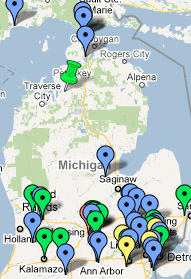Michigan needs great, walkable, urban places if it is to mount a serious economic recovery.
This is a refreshingly simple message, and one embraced by places like Chicago and Pittsburgh. But it has been a tough sell in Michigan.
The importance of the “built environment” – how and where residential housing, transportation infrastructure and commercial investment lands in our communities – has historically not been part of Michigan’s economic development strategy.
But through diverse groups like People and Land, which is co-sponsoring a series of prosperity forums in Michigan – and with federal partners at groups like Smart Growth America and Transportation For America – we are working to elevate the idea that placemaking needs to be front-and-center in conversations about economic
development and recovery.
The ideas of Christopher Leinberger, developer and director of the Graduate Real Estate Development Program at the University of Michigan, ought to get top billing for Michigan leaders hoping to rebuild an economy and retain our young professionals.
In essence, the idea is this: If we build places where the best and brightest want to live, our economy will reap the benefits in job creation, skilled workers and entrepreneurial activity. If we fail to build them, those same folks will continue to go elsewhere, taking their job skills, creativity and disposable income with them.
Michigan has not kept our young, talented professionals “because you’ve not offered them the walkable urban way of living, and they’ve left,” Leinberger says. “It’s not the only reason, of course, but it’s significant. You’ve got folks in this country that would love to move back to Michigan if there was any hope and any option that they could live the kind of life that they want to live.”
Leinberger suggests that adding more regionally significant, walkable urban places to the state’s real estate menu is a “necessary precondition for this state to move forward” economically.
Unfortunately, most of our current institutions and governmental structures – from local zoning ordinances to financing and underwriting of real estate development – were not built to facilitate this kind of walkable urban place. And we’ve been slow to recognize and react.
By restricting or outlawing mixed residential/commercial development and requiring quick, seven- to 10-year timelines to show a return on investments, we’ve made higher-quality communities harder to build-sometimes illegal, and often impossible to finance.
To turn things around, we need better regional cooperation, more consistent local land use plans and real investments in transportation options like commuter rail and light rail. Perhaps most important, we need public/private partnering focused on producing high-quality built environment options that lessen auto dependency.
Michigan’s legacy of success has also given us a unique opportunity. The network of old wealth in the state has provided us with strong and engaged foundations, big pension funds and major institutions. These are the building blocks that can yield new private public partnerships that provide access to the kinds of patient equity that build a
higher quality urban environment.
This all starts by realizing one thing – place matters. For Michigan and its footloose college grads, adding more walkable urban places might be the most important investment we can make.
Gil White is the past president of the Michigan Association of Realtors. Brad Garmon is land programs director at the Michigan Environmental Council. Both are on the Leadership Council of People and Land. This article appeared in the Detroit News on April 16, 2009.
















Leave a comment
Comments feed for this article